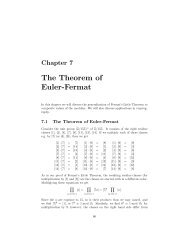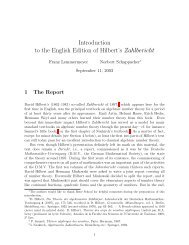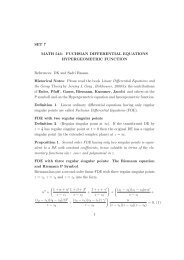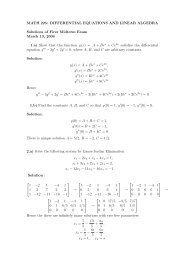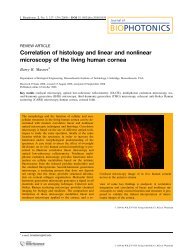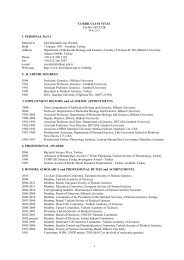History of the Optical Microscope in Cell Biology and Medicine
History of the Optical Microscope in Cell Biology and Medicine
History of the Optical Microscope in Cell Biology and Medicine
Create successful ePaper yourself
Turn your PDF publications into a flip-book with our unique Google optimized e-Paper software.
provided a solution to <strong>the</strong> problem <strong>of</strong> how to provide deeptissue<br />
imag<strong>in</strong>g with fluorescent dyes that absorb <strong>in</strong> <strong>the</strong> ultraviolet<br />
region without kill<strong>in</strong>g <strong>the</strong> cells.<br />
The development <strong>of</strong> various types <strong>of</strong> optical microscopes<br />
<strong>in</strong>corporated <strong>the</strong> follow<strong>in</strong>g components: microscope objectives<br />
that m<strong>in</strong>imize chromatic <strong>and</strong> o<strong>the</strong>r optical aberrations<br />
(image distortion), st<strong>and</strong>s that m<strong>in</strong>imize mechanical vibrations<br />
<strong>and</strong> sources <strong>of</strong> illum<strong>in</strong>ation from sunlight to lasers.<br />
Additionally, <strong>the</strong>re were new methods <strong>of</strong> fix<strong>in</strong>g <strong>and</strong> cutt<strong>in</strong>g<br />
specimens (microtomes), specimen sta<strong>in</strong><strong>in</strong>g techniques<br />
(dyes, sta<strong>in</strong>s, molecular probes) that <strong>in</strong>crease specimen contrast.<br />
Also important were <strong>the</strong> development <strong>of</strong> various<br />
optical methods that provide contrast (phase <strong>and</strong> differential<br />
<strong>in</strong>terference microscopes, fluorescence microscopes) for<br />
live cells, techniques for imag<strong>in</strong>g long-term live cell cultures<br />
(time-lapse <strong>and</strong> video-microscopy), optical techniques to<br />
provide optical section<strong>in</strong>g <strong>of</strong> specimens (confocal microscopes),<br />
<strong>and</strong> nonl<strong>in</strong>ear-optical imag<strong>in</strong>g techniques (multiphoton,<br />
harmonic generation <strong>and</strong> coherent anti-Stokes<br />
Raman microscopes). The history <strong>of</strong> <strong>the</strong> microscope is<br />
grounded <strong>in</strong> physics, specifically optics, but it <strong>in</strong>cludes<br />
glasses – <strong>the</strong>ir optical properties, <strong>the</strong>ir mechanical-<strong>the</strong>rmal<br />
properties <strong>and</strong> <strong>the</strong>ir manufacture <strong>and</strong> gr<strong>in</strong>d<strong>in</strong>g techniques –<br />
to produce optical components.<br />
Early <strong>Microscope</strong>s <strong>and</strong> Their Use<br />
The <strong>in</strong>vention <strong>of</strong> <strong>the</strong> microscope is credited to Zaccharias<br />
Janssen (1587–1638) <strong>and</strong> his son Hans Janssen (1534–<br />
1592), two Dutch eye glass makers who placed multiple<br />
lenses <strong>in</strong> a tube <strong>and</strong> observed <strong>the</strong> image was magnified.<br />
Antoni van Leeuwenhoek (1632–1723) used his s<strong>in</strong>gle<br />
lens microscope to observe s<strong>in</strong>gle bacterial cells <strong>and</strong> o<strong>the</strong>r<br />
microorganisms that he called ‘wee animalcules’. He studied<br />
many specimens <strong>in</strong>clud<strong>in</strong>g liver, bra<strong>in</strong>, fat <strong>and</strong> muscle<br />
tissues (sta<strong>in</strong>ed with a dye). Additionally, he observed <strong>the</strong><br />
cornea <strong>of</strong> <strong>the</strong> eye, <strong>the</strong> lens, <strong>the</strong> ret<strong>in</strong>a, <strong>the</strong> optic nerve, as well<br />
as biological fluids such as blood, ur<strong>in</strong>e, sweat <strong>and</strong> tears.<br />
van Leeuwenhoek observed <strong>the</strong> flow <strong>of</strong> blood globules<br />
(blood cells) <strong>in</strong> <strong>the</strong> capillaries <strong>in</strong> <strong>the</strong> gills <strong>of</strong> <strong>the</strong> tadpole; he<br />
noted that <strong>the</strong> flow was simultaneous with <strong>the</strong> heartbeat <strong>of</strong><br />
<strong>the</strong> tadpole. He was not aware <strong>of</strong> Malpighi’s discovery <strong>of</strong><br />
blood capillaries (1660) <strong>and</strong> red blood corpuscles (1674).<br />
In 1664 Robert Hooke (1635–1703), a contemporary <strong>of</strong><br />
Newton, published Micrographia, a book which attracted<br />
widespread attention to <strong>the</strong> microscope <strong>and</strong> its marvelous<br />
capabilities. Hooke wrote <strong>in</strong> <strong>the</strong> preface <strong>of</strong> Micrographia<br />
that his motivation for <strong>the</strong> book was to promote <strong>the</strong> use <strong>of</strong><br />
<strong>in</strong>struments <strong>in</strong> science. With his compound microscope <strong>and</strong><br />
an oil lamp as a light source, he observed <strong>the</strong> eye <strong>and</strong> <strong>the</strong><br />
morphology <strong>of</strong> common fly <strong>and</strong> he described <strong>the</strong> fruit<strong>in</strong>g<br />
structures <strong>of</strong> molds. Later <strong>in</strong> 1665, Hooke observed cells<br />
(similar to monk’s cells) <strong>in</strong> slices <strong>of</strong> cork <strong>and</strong> made similar<br />
observations <strong>of</strong> plant cells. Most importantly, he noted<br />
that <strong>the</strong> s<strong>in</strong>gle lens microscope is superior to <strong>the</strong> compound<br />
microscope s<strong>in</strong>ce <strong>the</strong> former had m<strong>in</strong>imal chromatic aberrations<br />
(different colours <strong>of</strong> light focus at different po<strong>in</strong>ts).<br />
2<br />
<strong>History</strong> <strong>of</strong> <strong>the</strong> <strong>Optical</strong> <strong>Microscope</strong> <strong>in</strong> <strong>Cell</strong> <strong>Biology</strong> <strong>and</strong> Medic<strong>in</strong>e<br />
A major advance <strong>in</strong> <strong>the</strong> design <strong>of</strong> microscope objectives<br />
occurred when Joseph Jackson Lister (1786–1869) developed<br />
his version <strong>of</strong> <strong>the</strong> achromatic objective with no spherical<br />
aberration. He used his new microscope objective<br />
(achromatic doublets <strong>and</strong> triplets that did not multiply <strong>the</strong><br />
spherical aberration <strong>and</strong> coma <strong>of</strong> each lens) to observe red<br />
blood cells <strong>and</strong> striated muscle. This was an important development<br />
because until <strong>the</strong> 1830s <strong>the</strong> compound microscope<br />
yielded low-quality images; on <strong>the</strong> contrary, <strong>the</strong><br />
s<strong>in</strong>gle lens microscope did not suffer from <strong>the</strong>se optical<br />
aberrations.<br />
Giaovanni Battista Amici (1786–1863) was ano<strong>the</strong>r <strong>in</strong>novator<br />
<strong>and</strong> developer <strong>of</strong> microscopes. He was <strong>the</strong> first to<br />
use an immersion objective to <strong>in</strong>crease <strong>the</strong> resolution (earlier<br />
suggested by Brewster). He used an ellipsoidal mirror<br />
objective to solve <strong>the</strong> problem <strong>of</strong> chromatic aberrations.<br />
This idea was first proposed by Christiaan Huygens as a<br />
method to avoid chromatic aberrations; earlier Newton<br />
made a similar proposal. Amici made three major improvements<br />
<strong>of</strong> <strong>the</strong> microscope: he developed a semispherical<br />
front lens achromatic microscope objective, he<br />
described <strong>the</strong> effect <strong>of</strong> coverslip thickness on image quality,<br />
<strong>and</strong> he <strong>in</strong>troduced <strong>the</strong> use <strong>of</strong> <strong>the</strong> water immersion microscope<br />
objectives.<br />
How were l<strong>in</strong>ear dimensions <strong>and</strong> resolution measured <strong>in</strong><br />
microscopes? The magnification <strong>of</strong> van Leeuwenhoek’s<br />
various microscopes ranged from 3 to 266 <strong>and</strong> <strong>the</strong><br />
resolution ranged from 1.3 to 8 mm. He measured size <strong>in</strong> his<br />
specimens by comparison with a gra<strong>in</strong> <strong>of</strong> s<strong>and</strong> or <strong>the</strong> diameter<br />
<strong>of</strong> a hair. Later, <strong>in</strong> <strong>the</strong> seventeenth <strong>and</strong> eighteenth<br />
centuries <strong>the</strong> resolv<strong>in</strong>g power <strong>of</strong> an objective was tested<br />
with <strong>the</strong> w<strong>in</strong>gs <strong>of</strong> <strong>in</strong>sects or <strong>the</strong> fea<strong>the</strong>rs <strong>of</strong> birds; <strong>and</strong> for<br />
higher resolution objectives, diatoms were <strong>the</strong> test objects.<br />
Over a period <strong>of</strong> decades <strong>the</strong> compound microscope<br />
began to atta<strong>in</strong> <strong>the</strong> look <strong>of</strong> <strong>the</strong> modern optical microscope.<br />
Christian Hertel (1683–1725) <strong>in</strong> 1712 developed <strong>the</strong> mechanical<br />
x–y stage to move <strong>the</strong> specimen with f<strong>in</strong>e mechanical<br />
control. In 1854, Camille Sebastien Nachet (1799–1881)<br />
<strong>in</strong>vented his version <strong>of</strong> <strong>the</strong> stereomicroscope that conta<strong>in</strong>ed<br />
two eyepieces. By 1897, <strong>the</strong> firm Zeiss manufactured its<br />
stereomicroscope that provided three-dimensional views <strong>of</strong><br />
<strong>the</strong> specimen.<br />
Advances <strong>in</strong> <strong>Microscope</strong> Design<br />
The credit for <strong>the</strong> first <strong>the</strong>oretical advances <strong>in</strong> microscope<br />
design based on physics is given to Ernst Abbe (1840–<br />
1906). In 1866, Abbe met Carl Zeiss, who proposed that<br />
Abbe establish a scientific foundation for <strong>the</strong> manufacture<br />
<strong>of</strong> optical microscopes. Abbe made <strong>the</strong>oretical contributions<br />
to <strong>the</strong> <strong>the</strong>ories <strong>of</strong> <strong>the</strong> resolv<strong>in</strong>g power <strong>of</strong> microscope,<br />
<strong>the</strong> role <strong>of</strong> diffraction <strong>in</strong> image formation, <strong>and</strong> <strong>the</strong> formation<br />
<strong>of</strong> aberrations. In 1872, Abbe formulated <strong>the</strong> ‘Abbe<br />
S<strong>in</strong>e Condition’ that permitted <strong>the</strong> design <strong>of</strong> objectives with<br />
maximum resolution <strong>and</strong> m<strong>in</strong>imal aberrations. He <strong>in</strong>vented<br />
<strong>the</strong> Abbe condenser <strong>in</strong> 1872 which illum<strong>in</strong>ated <strong>the</strong><br />
full aperture <strong>of</strong> <strong>the</strong> microscope objective <strong>and</strong> thus provided<br />
ENCYCLOPEDIA OF LIFE SCIENCES & 2008, John Wiley & Sons, Ltd. www.els.net



